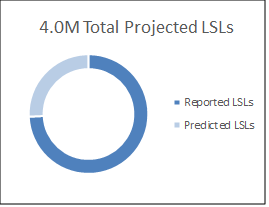EPA's 7th Drinking Water Infrastructure Needs Survey and Assessment
EPA's 7th Drinking Water Infrastructure Needs Survey and Assessment (DWINSA) assesses the nation’s public water systems’ infrastructure needs over the next 20 years and is used to allocate Drinking Water State Revolving Fund (DWSRF) grants, including Infrastructure Investment and Jobs Act (IIJA) funding, to states. The survey determined that drinking water systems will need $625 billion for pipe replacement, treatment plant upgrades, storage tanks, and other key assets to ensure the public health, security, and economic well-being of our cities, towns, and communities.
The 7th DWINSA also estimates that that needs of existing tribal drinking water infrastructure exceed $4 billion over the next 20 years and the survey results are used to allocate funds for tribes under the Drinking Water Infrastructure Grant Tribal Set-Aside (DWIG-TSA). The survey is comprised of infrastructure needs that are DWIG-TSA eligible, and include the installation of new drinking water infrastructure and the rehabilitation, expansion, or replacement of existing infrastructure.
- Drinking Water Infrastructure Needs Survey and Assessment: 7th Report to Congress (pdf)
- DWINSA: 7th Report to Congress Addendum - 2023 Update Lead Service Line Information (pdf)
- Fact Sheet: 7th DWINSA (pdf)
- FAQ: 7th DWINSA (pdf)
- DWSRF Allotments from 7th DWINSA and Previous DWINSA
7th DWINSA Lead Service Line Information
The 7th DWINSA now estimates a total of four million lead service lines. Review the fact sheets for more information:

- Fact Sheet: 2025 Update for DWSRF IIJA LSLR Allotments (pdf)
- Approach for FY 2025 and FY2026 Infrastructure Investment and Jobs Act (IIJA) LSLR Allotments: To use the best available information to allot FY 2025 and 2026 IIJA LSLR funds, the EPA is updating its approach under the 7th DWINSA to estimate lead service line-specific need by incorporating the LCRR initial inventory state summary counts into the 7th DWINSA. FY 2025 and FY 2026 BIL LSLR Allotments Memo (pdf)
- Fact Sheet: 2024 Updated 7th Drinking Water Infrastructure Needs Survey & Assessment (pdf)
- Fact Sheet: 2023 Update to the 7th DWINSA Lead Service Line Questionnaire (pdf)
- DWSRF LSLR Capitalization Grants
DWINSA Data and Dashboards
EPA’s 7th DWINSA results show that improvements are primarily needed in:
- Distribution and transmission: $422.9 billion to replace or rehabilitate aging or deteriorating pipelines and appurtenances.
- Treatment: $107 billion to construct, expand or rehabilitate infrastructure to reduce contamination.
- Storage: $56.1 billion to construct, rehabilitate or cover water storage reservoirs.
- Source: $25.2 billion to construct or rehabilitate intake structures and wells, or purchase water rights.
Data Download:
- 2025 Updated Service Line Projections (xlsx)
- 7th DWINSA Total Need (xlsx)
- 7th DWINSA Consolidated System Level Traditional Needs Data (xlsx)
- 2024 Updated 7th DWINSA State Level Service Lines (xlsx)
- 2024 Updated 7th DWINSA System Level Service Lines (xlsx)
